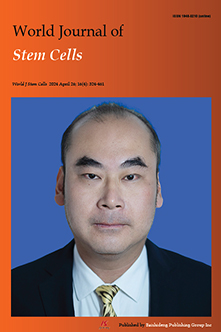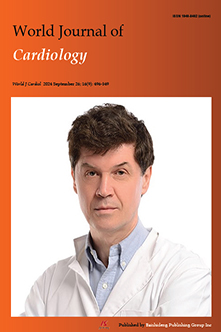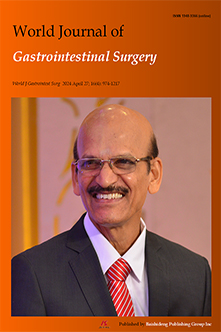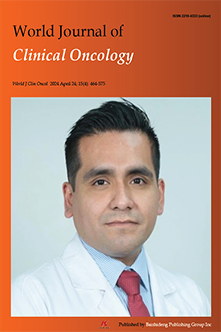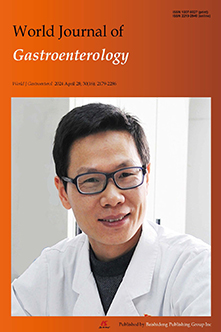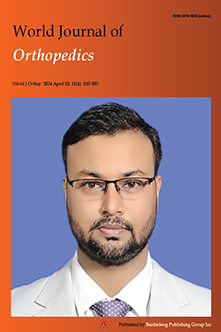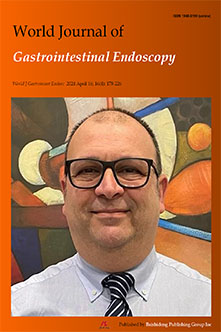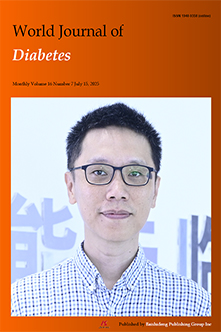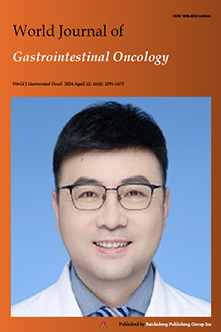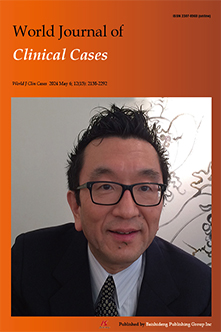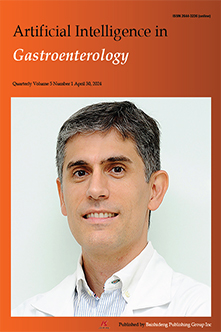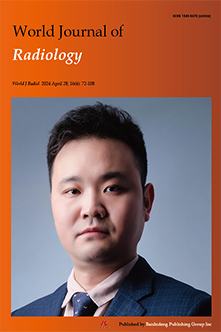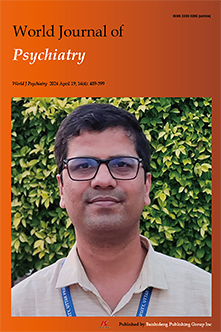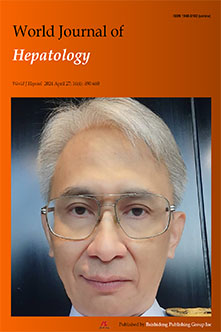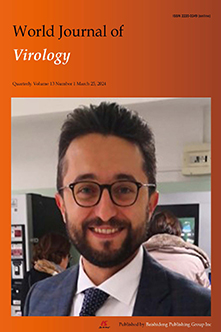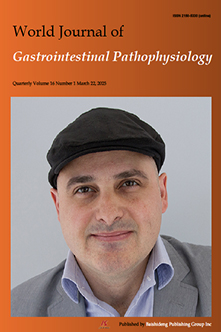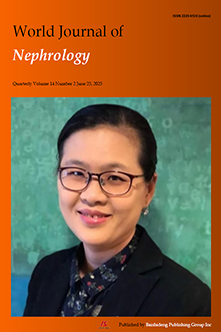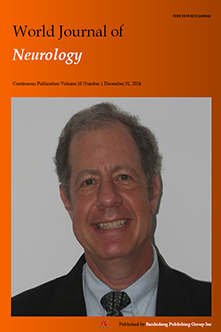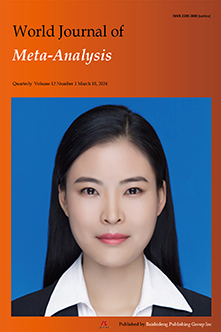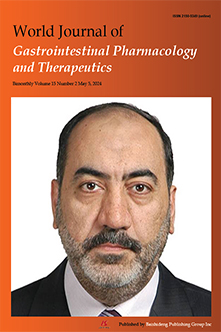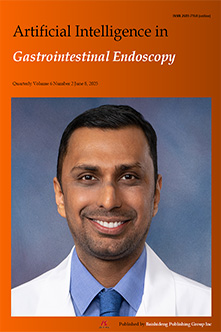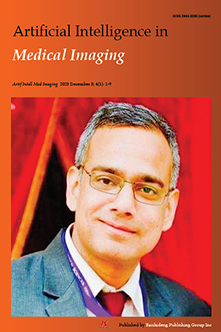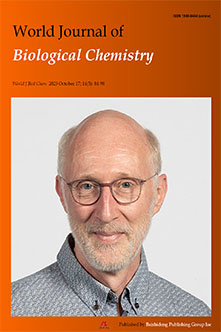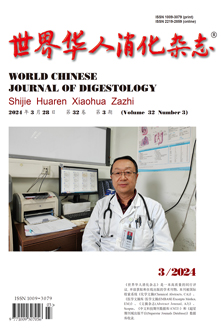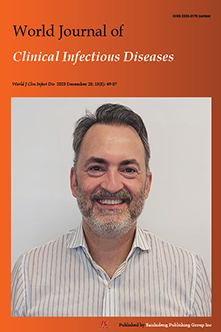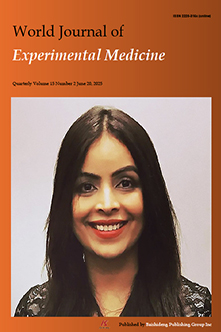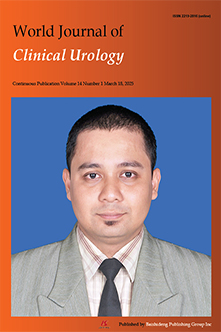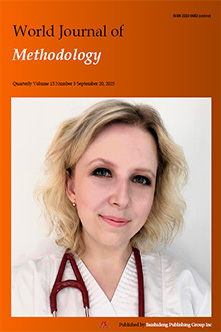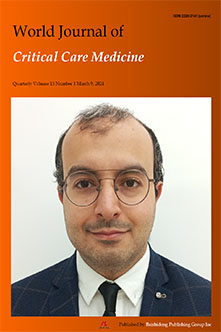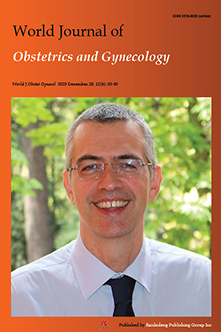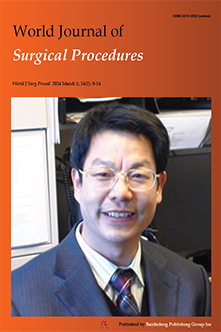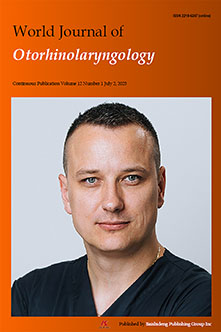Publisher Login
Manuscript Statistics
1
2
3
2025-10-24 | Browse: 23 | Download: 0
4
5
6
7
8
2025-10-24 | Browse: 16 | Download: 0
9
10
11
12
13
14
15
16
17
2025-10-24 | Browse: 22 | Download: 0
18
2025-10-24 | Browse: 38 | Download: 0
19
2025-10-24 | Browse: 33 | Download: 0
20
721 items Read more >>
1
"We are delighted to have our work published in this journal, which maintains rigorous standards and engages highly professional and ..."
[Read more]
"We are delighted to have our work published in this journal, which maintains rigorous standards and engages highly professional and meticulous peer reviewers. Its credibility is noteworthy, and we believe it is an excellent platform for submissions related to traditional Chinese medicine, complementary therapies, and stem cell research. We encourage everyone to actively consider submitting your work! "
[Collapse]
Lu DX, Wang ZX, Liu XM, Wu H, Ji LJ, Yan J. Wumei Pills enhance intestinal stem cell - mediated repair in chemotherapy-induced mucositis via Lactobacillus reuteri - dependent modulation of the gut microbiota. World J Stem Cells 2025; 17(9): 107025
2
"I am thoroughly satisfied with the entire process from submission to acceptance and final publication. WJSC is a remarkable journal, ..."
[Read more]
"I am thoroughly satisfied with the entire process from submission to acceptance and final publication. WJSC is a remarkable journal, and I would not hesitate to submit my future work here again. My sincere gratitude to the editor and all the peer reviewers for their valuable time and insightful comments. "
[Collapse]
Lv H, Zheng CF, Chen XY, Wei JH, Tao YZ, Feng L, Feng Z, Lu SJ. Sclerostin-silenced human umbilical cord mesenchymal stem cells ameliorate bone metabolism in steroid-induced femoral head necrosis. World J Stem Cells 2025; 17(10): 110190
3
"It was a rewarding submission experience. World Journal of Gastrointestinal Surgery is very formal and efficient. I can get timely ..."
[Read more]
"It was a rewarding submission experience. World Journal of Gastrointestinal Surgery is very formal and efficient. I can get timely answers to my questions, and the whole submission process is very smooth and efficient. Thank you very much for your comments and suggestions, so that the article has been further improved. Thank you very much. "
[Collapse]
Zhou QY, Zheng ZH, Lv XL, Guo JQ, Zhang K, Xu HT. Advancement in the diagnosis and treatment of hepatic portal venous gas. World J Gastrointest Surg 2025; 17(10): 109062
4
"We sincerely thank the editors and reviewers for their valuable feedback and constructive suggestions, which have greatly improved ..."
[Read more]
"We sincerely thank the editors and reviewers for their valuable feedback and constructive suggestions, which have greatly improved the quality of our manuscript. All comments have been carefully addressed, and necessary revisions were incorporated into the text, figures, and references. We believe the revised version better reflects the scientific rigor and clarity expected for publication. "
[Collapse]
Mahajan AA, Rajendran RL, Gangadaran P, Ahn BC. Engineering ligament tissues: Synergistic power of aligned nanofibers and cyclic stretch. World J Stem Cells 2025; 17(10): 112397
5
"Over the years, the World Journal has streamlined its process and expanded its horizon with quality publications. The author's site ..."
[Read more]
"Over the years, the World Journal has streamlined its process and expanded its horizon with quality publications. The author's site is updated and informative, and one can monitor the progress of the manuscript as it proceeds via the review and publication process. The staff are helpful, and the turnaround time for the staff is excellent. The reviewers are very well versed and there to help improve the quality of your manuscript. "
[Collapse]
Parsi S, Shirsat PD, Mahali LP, Surani S, Kashyap R. Sodium-glucose cotransporter 2 inhibitor in heart failure patients and their outcomes: A meta-analysis of randomized controlled trials. World J Cardiol 2025; 17(10): 109731
6
"Thank you for high standard peer review and editorial processes. Blinded review process and other editorial processes like improving ..."
[Read more]
"Thank you for high standard peer review and editorial processes. Blinded review process and other editorial processes like improving language and structure of the article. I advise authors to submit their studies to this publisher having high tech infrasturcture and user friendly interface. This journal will reach to a better place by means of indexing in mean time I think. Thank you. Best regards. "
[Collapse]
Sağsöz ME. Comprehensive study comparing different machine learning methods in computed tomography imaging. Artif Intell Med Imaging 2025; 6(1): 101264
7
"I do believe that the review process made improvements in the manuscript. We could delivery our message with more clarity. The ..."
[Read more]
"I do believe that the review process made improvements in the manuscript. We could delivery our message with more clarity. The reviewers made good contribution to improve the quality of manuscript even adding references and different perspective to our discussion. We appreciated it. Also we have received great support from the editorial board. Thank you all for your outstanding support. "
[Collapse]
de Camargo AV, de Mattos MD, Kawasaki MK, Gomes DNS, Borges ABB, Vazquez VL, Araujo RLC. Treatment of patients with multiple brain metastases by isolated radiosurgery: Toxicity and survival. World J Clin Oncol 2023; 14(10): 400-408
8
"Thank you sincerely for the thorough review and valuable feedback. Your insights help us improve and ensure the highest quality. We ..."
[Read more]
"Thank you sincerely for the thorough review and valuable feedback. Your insights help us improve and ensure the highest quality. We appreciate the time and effort you dedicated to evaluating our work, and we're grateful for your constructive suggestions. Your support and expertise are truly appreciated as we strive to enhance our project. "
[Collapse]
Teixeira MF, Borad M, Serrano Uson Junior PL. Circulating tumor DNA in biliary tract cancers: A review of current applications. World J Clin Oncol 2025; 16(10): 107875
9
"Thank you for the unique chance to publish our work in this prestigious journal. We would also like to thank the entire staff and ..."
[Read more]
"Thank you for the unique chance to publish our work in this prestigious journal. We would also like to thank the entire staff and the reviewers taking timpe in order to provide the useful suggestions and constructive advice that made a significant improvement to the manuscript. We are looking forward to further collaborations. "
[Collapse]
Minea H, Singeap AM, Minea M, Chiriac S, Stanciu C, Trifan A. Artificial intelligence in inflammatory bowel disease: Current applications and future directions. World J Gastroenterol 2025; 31(39): 111353
10
"Excellent experience with the World Journal of Clinical Oncology (WJCO). The publication process was remarkably fast, efficient, and ..."
[Read more]
"Excellent experience with the World Journal of Clinical Oncology (WJCO). The publication process was remarkably fast, efficient, and transparent, with a thorough yet agile peer-review system. The submission platform is intuitive and user-friendly, and communication with the editorial team was clear and professional throughout. A truly smooth and positive experience for authors. "
[Collapse]
González-Montero J, Valenzuela G, Rojas CI, Burotto M. Sidedness matters: Colon cancer outcomes in low-resource settings. World J Clin Oncol 2025; 16(10): 108937
11
"We are very satisfied with the overall process of manuscript review and editing, however, the publishing cost of your journal is too ..."
[Read more]
"We are very satisfied with the overall process of manuscript review and editing, however, the publishing cost of your journal is too expensive. Many scholars may be hesitant to submit to your journal due to the high publication fees. If the publishing cost can be reduced, it would be a good thing for us scholars. I suggest that your journal reduce its publication costs appropriately, so that more scholars can submit articles to your journal. "
[Collapse]
Qiu J, Wu JZ, Gu ZG, Qian JW, Shen T. Influencing factors and predictive model of the early postoperative recurrence of colorectal cancer with obstruction. World J Gastrointest Surg 2025; 17(10): 110695
12
"Many thanks for the opportunity to publish in a prestigious journal in the field of stem cell-based therapy and Regenerative Medicine. ..."
[Read more]
"Many thanks for the opportunity to publish in a prestigious journal in the field of stem cell-based therapy and Regenerative Medicine. It is an honor for us to have our publication. The whole process, encompassing the submission of the manuscript for review, review, editing, and online publication, has been very professional. My group would be happy to contribute to WJSC in the future. "
[Collapse]
Safwan M, Bourgleh MS, Al-Ruqi A, Shrebaty O, Almujaydil F, AlOthaim B, AlRashidi N, Haider KH. Living bio-drug therapies using mesenchymal stem cells and exosomes for mechanically ventilated patients with acute respiratory distress syndrome: A systematic review and meta-analysis. World J Stem Cells 2025; 17(10): 111978
13
"We are deeply grateful to the editors who handled our manuscript. We also thank the reviewers for their careful consideration. Their ..."
[Read more]
"We are deeply grateful to the editors who handled our manuscript. We also thank the reviewers for their careful consideration. Their comments greatly helped improve the quality of this manuscript. The editors were prompt and fair in their process. I am very satisfied with this journal and plan to continue submitting our manuscripts to it in the future. Thank you again. Greetings, "
[Collapse]
Byeon H. Structural brain correlates of neuropsychomotor performance in older adults with early cognitive decline. World J Psychiatry 2025; 15(10): 109273
14
"We are deeply grateful to the editors who handled our manuscript. We also thank the reviewers for their careful consideration. Their ..."
[Read more]
"We are deeply grateful to the editors who handled our manuscript. We also thank the reviewers for their careful consideration. Their comments greatly helped improve the quality of this manuscript. The editors were prompt and fair in their process. I am very satisfied with this journal and plan to continue submitting our manuscripts to it in the future. Thank you again. Greetings, "
[Collapse]
Akpoveta ED, Okpete UE, Byeon H. Unraveling the gut-liver axis in autoimmune liver disease overlap syndrome: A multi-omics perspective. World J Gastroenterol 2025; 31(37): 112298
15
"Thank you for the efficient publication process and the professional guidance provided during the review and editing stages. I truly ..."
[Read more]
"Thank you for the efficient publication process and the professional guidance provided during the review and editing stages. I truly appreciate the journal’s commitment to maintaining high academic standards and ensuring a smooth experience for authors. I am very satisfied with the overall process and look forward to future opportunities to publish more research in this journal. "
[Collapse]
Latsios G, Ktenopoulos N, Koliastasis L, Apostolos A, Kachrimanidis I, Mantzouranis E, Tolis E, Mantziaris V, Skalidis I, Tsalamandris S, Drakopoulou M, Synetos A, Aggeli C, Tsioufis C, Toutouzas K. Role of catheter-based interventions in treating pulmonary embolism. World J Cardiol 2025; 17(10): 111598
16
"We are deeply grateful to the World Journal of Clinical Oncology for their invaluable support in refining our manuscript from its ..."
[Read more]
"We are deeply grateful to the World Journal of Clinical Oncology for their invaluable support in refining our manuscript from its initial submitted draft to the final accepted version. The insightful and constructive comments provided by the esteemed reviewers, together with the professional editorial assistance and meticulous oversight from the Chief Editor and the Editorial Board, substantially enhanced the scientific rigor and overall presentation of our work. We sincerely appreciate their time, expertise, efforts and commitment throughout the peer-review and publication process. We are truly honored to have our manuscript published in the World Journal of Clinical Oncology. "
[Collapse]
Rather RA. Oncogenic B-Raf proto-oncogene, serine/threonine kinase-mediated hedgehog signalling in the pathogenesis and targeted therapy of melanoma. World J Clin Oncol 2025; 16(10): 105117
17
"I encountered some difficulties in adding the references and uploading the supporting documents in the portal, which could be ..."
[Read more]
"I encountered some difficulties in adding the references and uploading the supporting documents in the portal, which could be simplified. While the peer review process was very quick, the post-review period for the second decision and the time from acceptance to publication were relatively long. The production editors provided excellent proofreading and support. "
[Collapse]
Sekhar A, Kandasamy M. Heart-brain axis, gliotransmitters and peripheral neurogenesis: Emerging regenerative roles of cardiac nexus glia in health and disease. World J Cardiol 2025; 17(10): 109174
18
"I would like to express my gratitude to all the teachers in the editorial department for their support and assistance. Your journal ..."
[Read more]
"I would like to express my gratitude to all the teachers in the editorial department for their support and assistance. Your journal has a fast review process and the review comments are very fair and helpful in improving the quality of the manuscripts. If there are any more manuscripts, I plan to continue submitting them to your publication. "
[Collapse]
Pan J, Zhang RS, Chen Y, Cao XH, Yang ZH, Lu L, Chen YT, Chu XY. Long-term survival after multimodality treatment of metastatic mixed adenoneuroendocrine carcinoma of colon: A case report. World J Gastrointest Surg 2025; 17(10): 111975
19
"We would like to express our gratitude to the assistant editor, scientific editor, peer reviewers, editorial office director, journal ..."
[Read more]
"We would like to express our gratitude to the assistant editor, scientific editor, peer reviewers, editorial office director, journal editor-in-chief, company editor-in-chief, language editor, production editor, and the entire World Journal of Gastrointestinal Surgery team for their dedicated efforts throughout the publication process of our manuscript. The World Journal of Gastrointestinal Surgery is beautifully produced, featuring clear images and visually appealing pages. My colleagues and I are deeply honored to have our work published in this esteemed journal. The journal operates with remarkable speed in its review of manuscripts, maintaining an open and transparent peer review process that delivers highly professional and thorough evaluations. The entire editorial team demonstrates exceptional diligence, a consistently friendly attitude, and outstanding expertise. We look forward to submitting further work to the World Journal of Gastrointestinal Surgery. "
[Collapse]
He YF, He QT. Single-port laparoscopic hernia needle therapy: New hope for the treatment of inguinal hernia in children. World J Gastrointest Surg 2025; 17(10): 106800
20
"Dear Editor I would like to express my sincere gratitude to you and the editorial team of the World Journal of Gastrointestinal Surgery ..."
[Read more]
"Dear Editor I would like to express my sincere gratitude to you and the editorial team of the World Journal of Gastrointestinal Surgery for publishing my article, I deeply appreciate the time, effort, and constructive feedback provided during the peer review and editing process.It is an honor to have my work featured in such a respected journal, and I am grateful for the opportunity to contribute to the field. Please extend my thanks to the reviewers and the entire publication team for their professionalism and support throughout the process. Thank you once again for your valuable guidance and assistance. With warm regards Dr Ankit Shukla "
[Collapse]
Shukla A, Kalayarasan R, Gochhait D, Harichandrakumar KT, Pottakkat B. Assessment of the status of micrometastasis and tumor spillage among the patients undergoing thoracoscopic esophagectomy for carcinoma esophagus. World J Gastrointest Surg 2025; 17(10): 107741
19752 items Read more >>
1
"Artificial intelligence has brought about a real revolution in various areas of human activities, including medical science. In recent ..."
[Read more]
"Artificial intelligence has brought about a real revolution in various areas of human activities, including medical science. In recent years, AI has also emerged as a method to support the correct diagnosis and treatment of acute pancreatitis. Some elements of AI, such as machine learning, deep learning, natural language processing, and network pharmacology, seem to significantly facilitate diagnostic and therapeutic decisions in the treatment of patients with acute pancreatitis, through the analysis of clinical records, medical images, laboratory values, genomic data, and physiological signals in real time. AI functions as advanced decision support, enhancing clinical judgment with intelligence derived from diagnostic data, assessing risks to the patient from potential complications, and helping safely predict the disease. The authors also discuss future directions for AI development in the treatment of acute pancreatitis. As emphasized by the authors of this review, today's practical medicine often requires an interdisciplinary approach that integrates clinical experience, computational modeling, and ethical design. These largely theoretical data currently have limited application, especially in developing countries worldwide. For all health systems and in any country where AI is applied, its assistance should consist of improving decision-making through hybrid human-artificial intelligence models. The future looks excellent, although it causes concern and fear to the undersigned."
[Collapse]
Zhang XY, Hu MD, Maimaitijiang D, Wang T, Wang L. Artificial intelligence in pancreatitis: A narrative review on advancing precision diagnosis, prognosis, and therapeutic strategies. World J Gastroenterol 2025; 31(39): 110971
2
"This review explores the bidirectional regulation between the gut microbiome and the immune system within the colorectal cancer (CRC) ..."
[Read more]
"This review explores the bidirectional regulation between the gut microbiome and the immune system within the colorectal cancer (CRC) microenvironment. It highlights how microbial metabolites and immune signaling pathways influence tumor progression, immune evasion, and therapeutic response. Key mechanisms include TLR4 and NLRP3 activation, SCFA modulation, and PD-1 pathway interactions. The authors discuss emerging interventions such as engineered probiotics, FMT, and metabolic vaccines targeting the microbiota-immune axis. Overall, the study provides a comprehensive framework for developing personalized CRC therapies through microbiome modulation."
[Collapse]
Liu XX, Yang B, Tang DX. Bidirectional regulation of the gut microbiome-immune axis in the immune microenvironment of colorectal cancer and targeted interventions. World J Gastrointest Oncol 2025; 17(10): 109503
3
"This retrospective two-center study investigates ultrasound features of primary intestinal lymphoma in children and their correlation ..."
[Read more]
"This retrospective two-center study investigates ultrasound features of primary intestinal lymphoma in children and their correlation with prognosis. Twenty-eight pediatric cases were classified into focal segmental and extensive types based on sonographic findings. Extensive-type lymphoma was associated with significantly elevated LDH levels and poorer outcomes compared to the segmental type. Ultrasound classification and LDH levels showed strong prognostic relevance, while pathological type, age, and treatment modality did not. The study concludes that ultrasound is a valuable tool for diagnosis, classification, and prognosis prediction in pediatric intestinal lymphoma."
[Collapse]
Huang SF, Yang F, Chen WJ, Zhang XH. Ultrasound features of primary intestinal lymphoma in children and their correlation with prognosis: A two-center experiment. World J Gastrointest Oncol 2025; 17(10): 109450
4
"This review highlights how lipid metabolic reprogramming drives colorectal cancer (CRC) progression, immune evasion, and therapy ..."
[Read more]
"This review highlights how lipid metabolic reprogramming drives colorectal cancer (CRC) progression, immune evasion, and therapy resistance. It discusses key alterations in fatty acid synthesis, oxidation, and cholesterol metabolism, as well as the impact of high-fat diets and gut microbiota on the tumor microenvironment. The authors emphasize the role of lipid metabolism in shaping immunosuppressive dynamics and promoting cancer stemness and metastasis. By identifying actionable lipid-related pathways and enzymes, the review proposes novel therapeutic strategies, including combinations with immunotherapy. Overall, it offers a comprehensive and timely framework for advancing precision oncology in CRC."
[Collapse]
Wang CD, Zhang BX, Song J. Lipid metabolic reprogramming in colorectal cancer: Insights to mechanisms and therapeutics. World J Gastrointest Oncol 2025; 17(10): 109398
5
"This multicenter retrospective study analyzed 189 colorectal cancer (CRC) patients admitted to intensive care units (ICUs) across ..."
[Read more]
"This multicenter retrospective study analyzed 189 colorectal cancer (CRC) patients admitted to intensive care units (ICUs) across 37 cancer-specialized hospitals in China. The 90-day mortality rate was relatively low at 12.2%, with elective surgery and conventional oxygen therapy associated with better outcomes. Chemotherapy history and unplanned ICU transfers were linked to higher mortality, while severity scores like SOFA and APACHE II showed only moderate predictive value. This study is commendable for its large-scale, multicenter design and its focus on a clinically important yet underexplored patient population. By identifying key prognostic factors and highlighting the limitations of current scoring systems, the authors provide valuable insights that can inform ICU admission decisions and personalized care strategies for CRC patients."
[Collapse]
Dong Q, Xia R, Xing XZ, Wang CS, Ma G, Wang HZ, Zhu B, Zhao JH, Zhou DM, Zhang L, Huang MG, Quan RX, Ye Y, Zhang GX, Jiang ZY, Huang B, Xu SL, Xiao Y, Zhang LL, Lin RY, Ma SL, Qiu YA, Zheng Z, Sun N, Xian LW, Li J, Zhang M, Guo ZJ, Tao Y, Zhou XZ, Chen W, Wang DX, Chi JY, Wang DH, Liu KZ. Intensive care unit outcomes and prognostic factors of colorectal cancer. World J Gastrointest Oncol 2025; 17(10): 108539
6
"This review highlights the link between ulcerative colitis (UC) and colitis-associated colorectal cancer (caCRC), emphasizing how ..."
[Read more]
"This review highlights the link between ulcerative colitis (UC) and colitis-associated colorectal cancer (caCRC), emphasizing how chronic inflammation drives cancer development. It outlines key molecular pathways, immune responses, and microbiota changes involved in this process, and discusses current strategies for surveillance, chemoprevention, and surgical management. The authors advocate for precision medicine approaches to improve early detection and personalized care. The manuscript is commendable for its comprehensive integration of molecular and clinical insights. By combining updated surveillance guidelines with emerging biomarker research, it offers a forward-thinking framework that can guide more effective prevention and treatment strategies for caCRC in UC patients."
[Collapse]
Catalano M, Mini E, Nobili S, Vascotto IA, Ravizza D, Amorosi A, Tonelli F, Roviello F, Roviello G, Nesi G. Ulcerative colitis and colorectal cancer: Pathogenic insights and precision strategies for prevention and treatment. World J Gastrointest Oncol 2025; 17(10): 108514
7
"1 Ethics: Not applicable
2 Methods: Case report that the manuscript was prepared and revised according to the CARE Checklist ..."
[Read more]
"1 Ethics: Not applicable
2 Methods: Case report that the manuscript was prepared and revised according to the CARE Checklist (2016).
3 Results: case sharing of case presentation, findings and images.
4 Figures and tables: The author provides perfect images which is good quality and easily understandable plus interesting findings.
5 Biostatistics: Not applicable
6 References: Record the latest references which are important in this field and related to the scientific problems and case addressed in the study.
7 Language: The language in article correctly, clearly and concisely express the information. No grammatical and language mistakes.
8 Caveats or drawbacks: Not detected"
[Collapse]
Wang WQ, Yang JP, Dong JW, Chen YB. Misdiagnosis of Crohn’s disease as appendicitis: A case report. World J Gastrointest Surg 2025; 17(9): 108348
8
"1 Ethics: Not applicable
2 Methods: Case report that the manuscript was prepared and revised according to the CARE Checklist ..."
[Read more]
"1 Ethics: Not applicable
2 Methods: Case report that the manuscript was prepared and revised according to the CARE Checklist (2016).
3 Results: case sharing of case presentation, findings and images.
4 Figures and tables: The author provides good images which is good quality and easily understandable. Can be better figures intra-operative
5 Biostatistics: Not applicable
6 References: Record the latest references which are important in this field and related to the scientific problems and case addressed in the study.
7 Language: The language in article correctly, clearly and concisely express the information. No grammatical and language mistakes.
8 Caveats or drawbacks: Not detected"
[Collapse]
Zhang J, Sun S, Zheng S, Ma YY, Chen G. Gastric adenomyoma in children: A case report. World J Gastrointest Surg 2025; 17(9): 107297
9
"1 Ethics: Not applicable
2 Methods: Case report that the manuscript was prepared and revised according to the CARE Checklist ..."
[Read more]
"1 Ethics: Not applicable
2 Methods: Case report that the manuscript was prepared and revised according to the CARE Checklist (2016).
3 Results: case sharing of case presentation, findings and images.
4 Figures and tables: The author provides perfect images which is good quality and easily understandable.
5 Biostatistics: Not applicable
6 References: Record the latest references which are important in this field and related to the scientific problems and case addressed in the study.
7 Language: The language in article correctly, clearly and concisely express the information. No grammatical and language mistakes.
8 Caveats or drawbacks: Not detected"
[Collapse]
Moon YJ, Lee SH. Inferior mesenteric arteriovenous fistula: Two case reports. World J Gastrointest Surg 2025; 17(9): 107139
10
"1 Ethics: Not applicable
2 Methods: Case report that the manuscript was prepared and revised according to the CARE Checklist ..."
[Read more]
"1 Ethics: Not applicable
2 Methods: Case report that the manuscript was prepared and revised according to the CARE Checklist (2016).
3 Results: case sharing of case presentation, findings and images.
4 Figures and tables: The author provides good images which is good quality and easily understandable. need arrow in intra-operative image
5 Biostatistics: Not applicable
6 References: Record the latest references which are important in this field and related to the scientific problems and case addressed in the study.
7 Language: The language in article correctly, clearly and concisely express the information. No grammatical and language mistakes.
8 Caveats or drawbacks: Not detected"
[Collapse]
Ahunayizhi A, Zhang XL, Chen Q, Wang H, Ding G, Akumuo S, Wang XX, Ruan XJ. Laparoscopic management of gallstones in a duplicate gallbladder with double cystic ducts: A case report. World J Gastrointest Surg 2025; 17(9): 110796
11
"1 Ethics: Not applicable
2 Methods: Case report that the manuscript was prepared and revised according to the CARE Checklist ..."
[Read more]
"1 Ethics: Not applicable
2 Methods: Case report that the manuscript was prepared and revised according to the CARE Checklist (2016).
3 Results: case sharing of case presentation, findings and images.
4 Figures and tables: The author provides not medical photograph especially resected specimens photo.
5 Biostatistics: Not applicable
6 References: Record the latest references which are important in this field and related to the scientific problems and case addressed in the study.
7 Language: The language in article correctly, clearly and concisely express the information. No grammatical and language mistakes.
8 Caveats or drawbacks: Not detected"
[Collapse]
Guo Q, Lu HY, Lyu H, Tian H, Zhao Q, Zheng YC. Complete appendiceal intussusception and appendiceal mucinous tumor: A case report and review of literature. World J Gastrointest Surg 2025; 17(9): 109320
12
"This is a very interesting analysis and "observational" association between BMI and ALF. This work supports the knowledge about obesity ..."
[Read more]
"This is a very interesting analysis and "observational" association between BMI and ALF. This work supports the knowledge about obesity and the worldwide problem it represents as a health problem. With all due respect, this work lacks further analysis (hypothesis) on how this increased BMI contributes to organ failure. Further analysis should focus not only on organ (liver in this case) failure but on gastrointestinal symptomatology (effects) in general."
[Collapse]
Krishnan A, Khan S, Gips J, Alqahtani SA, Vaidya D, Liu YS, Kim A, Su A, Gurakar A, Hamilton JP, Woreta TA. Body mass index and its association with clinical outcomes in acute liver failure. World J Clin Cases 2025; 13(30): 109212
13
"1 Ethics: Ethical approval is stated as obtained from a relevant committee, meeting requirements.
2 Methods: Experimental methods ..."
[Read more]
"1 Ethics: Ethical approval is stated as obtained from a relevant committee, meeting requirements.
2 Methods: Experimental methods (cell culture, molecular/functional assays, microscopy) are standard, well-described, and repeatable via established protocols/citations.
3 Results: Results are authentic (consistent dose-effects, clear molecular data). The hypothesis that Prdx1 inhibits CRC via pyroptosis is partially validated (robust in vitro support, but lacks in vivo/clinical evidence for universal significance). Notably, the loading control (β-actin) appears uneven between N17 and T17 samples, which may raise minor concerns about sample loading consistency. While the study uses three cell lines to validate findings—enhancing data volume and credibility—it would further strengthen translational relevance if the authors validated Prdx1’s effects using patient-derived organoids (PDOs), which better recapitulate in vivo tumor biology.
4 Figures and tables: Figures are well-constructed with clear annotations, and tables present data effectively. However, most images rely heavily on black-and-white visuals, which could be aesthetically enhanced (e.g., using color coding for different groups or molecular targets) to improve readability and visual communication of key results.
5 Biostatistics: Statistical analyses are appropriately applied, with accurate p-values and data visualization (error bars, sample sizes).
6 References: Citations include key recent works on pyroptosis, inflammasomes, and CRC; citations are scientific, relevant, and not overly self-referential.
7 Language: Language is clear, concise, and grammatically correct.
8 Caveats or drawbacks: Animal-level experimental validation is insufficient; currently, only tumor size is assessed. Supplementing with detection of relevant proteins (e.g., NLRP3, GSDMD, caspase-1) or gene expression in tumor tissues from animal models would more be much better.
In summary, this study is well-conducted, utilizing paired tumor and adjacent non-tumor tissues from 20 patients, which enhances its clinical relevance. To further extend the current findings, it would be valuable for the authors to employ clinical specimens for establishing patient-derived organoids (PDOs) or patient-derived xenograft (PDX) models in future work, thereby validating the results in an in vivo context. Additionally, given the involvement of immunogenic cell death (ICD) discussed in the study, subsequent research could also explore the efficacy and underlying mechanisms related to tumor immunity.
"
[Collapse]
He Y, Liu J, Zhou N, Xie LX, Jiang YF, Chen CL. Peroxiredoxin 1 inhibits tumorigenesis by activating the NLRP3/GSDMD pathway to induce pyroptosis of colorectal cancer cells. World J Gastroenterol 2025; 31(36): 111557
14
"This large-scale, 20-year retrospective study by Huang et al. is a significant achievement, successfully establishing the first ..."
[Read more]
"This large-scale, 20-year retrospective study by Huang et al. is a significant achievement, successfully establishing the first genome-wide polygenic risk score (PRS) for diabetic retinopathy (DR) in a Taiwanese Han population. The study's key contribution is demonstrating that a high PRS is strongly associated not just with DR incidence, but more critically, with disease severity requiring interventions like laser treatment or surgery. This suggests the PRS could be a valuable tool for identifying patients needing more intensive monitoring.
Despite these strengths, the study highlights a crucial unresolved issue: the clinical utility of the PRS beyond existing risk factors. The central question remaining is whether this genetic information provides actionable predictive power over and above standard clinical data such as HbA1c and diabetes duration. Furthermore, the findings' generalizability to other ethnicities is yet to be determined, as the study was confined to a specific Asian population.
Therefore, the essential next step is to conduct prospective validation studies aimed at creating an integrated risk model. Such a model would combine the PRS with established clinical variables to definitively quantify its added value in personalizing DR screening strategies and improving patient outcomes."
[Collapse]
Huang YC, Liao WL, Lin HJ, Huang YT, Chang YW, Yang JS, Weng AL, Tsai FJ. Polygenic risk score for predicting diabetic retinopathy in patients with type 2 diabetes: A twenty-year follow-up study. World J Diabetes 2025; 16(10): 110138
15
"This is a thoughtful and well-executed study that provides a valuable, quantitative analysis of the interplay between type 2 diabetes ..."
[Read more]
"This is a thoughtful and well-executed study that provides a valuable, quantitative analysis of the interplay between type 2 diabetes (T2D), dry eye syndrome (DES), and corneal neuropathy. A significant strength of this paper lies in its robust methodology, which combines standardized subjective questionnaires (SPEED) with objective clinical measures (NIBUT, SIt) and advanced imaging through corneal confocal microscopy.
Despite these strengths, the study's contributions are constrained by limitations inherent in its design, which the authors commendably acknowledge. The primary issue is the retrospective, single-center nature of the research and the relatively small sample size of the DES group (n=27). This framework, while excellent for identifying strong associations, cannot establish causality. A critical unanswered question remains: does poor glycemic control directly cause corneal neuropathy which then leads to DES, or do these pathologies develop in parallel? The cross-sectional data cannot delineate this temporal sequence. Another unresolved problem is the potential confounding influence of systemic diabetic peripheral neuropathy. The study does not differentiate whether the observed corneal neuropathy is an isolated ocular pathology or a manifestation of a wider systemic nerve degeneration. This distinction is vital, as it carries different implications for both prognosis and treatment.
To build upon this solid foundation, the next logical step would be to conduct a large-scale, prospective, multicenter cohort study. Following patients over several years would allow for the establishment of a causal sequence between fluctuations in glycemic control, the onset and progression of corneal nerve damage, and the emergence of clinical DES. Such a study should also incorporate comprehensive neurological examinations to contextualize the corneal findings within the patient's overall systemic neuropathy status. Further investigation into the underlying biological mechanisms, perhaps by analyzing inflammatory biomarkers in the tear film of these patients, could also illuminate the pathway from hyperglycemia to nerve damage, potentially revealing new therapeutic targets beyond blood sugar management."
[Collapse]
Han WT, Zhao J, Feng WL, Ma WT. Type 2 diabetes complicated by dry eye syndrome: Analysis of dry eye symptoms, corneal neuropathy, and influencing factors. World J Diabetes 2025; 16(10): 109080
16
"In the 1970s and 1980s, vagotomy was widely used for duodenal ulcers. However, with the widespread use of PPIs and high rates of ..."
[Read more]
"In the 1970s and 1980s, vagotomy was widely used for duodenal ulcers. However, with the widespread use of PPIs and high rates of recurrence, vagotomy soon fell out of favor. However, it has now been reported that patients who have undergone vagotomy have a lower incidence of Parkinson's disease, based on the brain-gut axis. The authors report a high incidence of IBD 10 years after vagotomy. I believe this paper is an excellent theoretical explanation of the relationship between vagotomy and organs such as gut flora."
[Collapse]
da Silva ACA, Severo JS, dos Santos BLB, Soares HS, Martins JA, Lima RSP, Gadelha KKL, Torres-Leal FL, Correia-de-Sá P, Magalhães PJC, Santos AA, da Silva MTB. Role of physical exercise, vagal nerve stimulation, and vagotomy in inflammatory bowel disease. World J Gastroenterol 2025; 31(38): 111252
17
"This retrospective cohort study from Johns Hopkins University provides important evidence linking body mass index (BMI) to adverse ..."
[Read more]
"This retrospective cohort study from Johns Hopkins University provides important evidence linking body mass index (BMI) to adverse outcomes in acute liver failure (ALF). Analyzing 196 patients over two decades, the authors found that both overweight and obesity independently doubled the risk of death or liver transplantation. Given the rarity of ALF, this well-characterized cohort and rigorous statistical analysis make the findings clinically meaningful.
The study’s strengths include clear case definition using AASLD criteria, comprehensive data collection, and appropriate use of multivariable Cox regression and Kaplan–Meier analysis. The results are consistent with prior evidence from the Acute Liver Failure Study Group, reinforcing obesity as a significant prognostic factor. Importantly, overweight and obese patients showed higher rates of advanced hepatic encephalopathy and renal dysfunction, emphasizing the metabolic and inflammatory burden in this population.
However, BMI alone may not accurately represent metabolic health. Future studies incorporating waist circumference, hepatic fat indices, or noninvasive imaging markers could improve risk stratification. Moreover, temporal changes in critical care and transplant practices warrant consideration across the 20-year study period.
Overall, this well-designed and clinically valuable study strengthens the link between metabolic dysfunction and ALF outcomes. Incorporating BMI or related measures into existing prognostic models could further refine risk prediction and guide early intervention."
[Collapse]
Krishnan A, Khan S, Gips J, Alqahtani SA, Vaidya D, Liu YS, Kim A, Su A, Gurakar A, Hamilton JP, Woreta TA. Body mass index and its association with clinical outcomes in acute liver failure. World J Clin Cases 2025; 13(30): 109212
18
"This article offers an in-depth overview of current adjuvant strategies and their challenges in treating HCC. The authors note that ..."
[Read more]
"This article offers an in-depth overview of current adjuvant strategies and their challenges in treating HCC. The authors note that China represents nearly half of global HCC cases. Despite surgical resection, recurrence rates remain high and five-year survival rates low. The article reviews nine adjuvant approaches, but their effectiveness is still uncertain.
While the review is concise, it would benefit from clearer organization—such as using subsections for each therapy focusing on efficacy, challenges, and prospects for future research. Including a comparative table summarizing the therapies could also enhance understanding. The review lacks a critical evaluation of the referenced studies. Expanding on emerging therapies, their mechanisms, and potential advantages would strengthen the analysis. Additionally, incorporating data from other regions would offer a more comprehensive perspective on global HCC management.
"
[Collapse]
Liu F, Zhang J, Li K. Postoperative adjuvant management in hepatocellular carcinoma: A review of therapeutic efficacy and prognostic outcomes. World J Hepatol 2025; 17(9): 107631
19
" The manuscript is written well. Its structure is appropriate for this type of article. Ethical approval form meets the requirements. ..."
[Read more]
" The manuscript is written well. Its structure is appropriate for this type of article. Ethical approval form meets the requirements. Methods are appropriate and effective. Results are appropriate of methods and are authentic. Tables and biostatistics data are perfect. The references are adequate of topic. Language of article is satisfied."
[Collapse]
Barbosa OA. Small bowel ulcers and bleeding: An overlooked yet critical clinical challenge. World J Clin Cases 2025; 13(30): 109445
20
" The manuscript is written well. Its structure is appropriate for this type of article. Ethical approval form meets the requirements. ..."
[Read more]
" The manuscript is written well. Its structure is appropriate for this type of article. Ethical approval form meets the requirements. Methods are appropriate and effective. Results are appropriate of methods and are authentic. Tables and biostatistics data are perfect. The references are adequate of topic. Language of article is satisfied."
[Collapse]
Curto A, Iamello RG, Lynch EN, Galli A. Advancing the management of primary biliary cholangitis: From pathogenesis to emerging therapies. World J Clin Cases 2025; 13(30): 109028
15824 items Read more >>
Peer-Reviewers and Manuscript Statistics
- Editorial board members
- 2264
- Peer-reviewers
- 34237
- Manuscripts received today
- 4
- Manuscript reviews today
- 9
- Unhandled manuscripts today
- 163
- Active peer-reviewers today
- 843
- Reviewer acceptance today
- 11
- Reviewer refusals today
- 10
- Total accepted manuscripts
- 38208
- Total rejected manuscripts
- 43421
- Total peer-reviewers
- 4442493
- Total submissions
- 36326
1
2025-12-20 | Browse: 5156 | Download: 262
2
2025-12-20 | Browse: 5554 | Download: 428
3
4
2025-12-20 | Browse: 4365 | Download: 271
5
2025-12-20 | Browse: 5049 | Download: 301
6
7
8
9
2025-12-20 | Browse: 5046 | Download: 322
10
11
12
2025-12-20 | Browse: 4420 | Download: 340
13
14
15
16
17
2025-12-20 | Browse: 5078 | Download: 322
18
19
20
2025-12-20 | Browse: 4153 | Download: 251
60538 items Read more >>
1
2025-10-24 | Browse: 4 | Download: 14
2
2025-10-24 | Browse: 3 | Download: 15
3
4
5
6
7
8
9
10
11
12
13
14
15
16
2025-10-21 | Browse: 39 | Download: 91
17
2025-10-21 | Browse: 30 | Download: 95
18
2025-10-21 | Browse: 27 | Download: 109
19
20
10014 items Read more >>
72661 items Read more >>
1
"This study offers a compelling and innovative exploration of colonoscopy quality, addressing the critical interplay between insertion ..."
[Read more]
"This study offers a compelling and innovative exploration of colonoscopy quality, addressing the critical interplay between insertion time and withdrawal duration to optimize adenoma detection rate (ADR). The proposed "insertion-to-withdrawal" paradigm marks a significant departure from fixed withdrawal time standards, advocating for a personalized approach—a novel and practical advancement. The development of a Shiny app to deliver real-time, individualized guidance further enhances its clinical relevance, providing endoscopists with a valuable tool to improve outcomes. Several aspects warrant deeper consideration. First, the hybrid SVM-XGBoost model's modest discriminative performance (AUC ≈ 0.64) suggests limitations in its current predictive power, likely due to unaddressed variables such as bowel preparation nuances, insertion difficulty, or segment-specific inspection times. Expanding the dataset with multicenter inputs and incorporating these factors could refine its accuracy. Second, while insertion time serves as a proxy for procedural complexity, its validation against objective difficulty scales or video analysis would bolster the mechanistic basis of the findings. Third, the personalized strategy’s generalizability remains untested; prospective multicenter validation across diverse demographics, endoscopist expertise, and regions is essential. Finally, evaluating real-world app adoption and its impact on ADR adherence would provide critical evidence of its efficacy. Overall, this study lays a robust foundation for data-driven personalization in endoscopy, moving beyond uniform metrics. With further refinement and validation, it has the potential to transform clinical practice significantly. "
[Collapse]
Xu BX, Xu CZ, Zhang HY, Chen XJ, Wei BN, Yang C. Personalizing withdrawal time by insertion time to achieve target adenoma detection rate in colonoscopy. World J Gastroenterol 2025; 31(38): 111364
2
"I want to congratulate Yang-Yang Xiong for publishing an excellent study comparing Endoscopic Clip or EUS Coil-assisted glue for ..."
[Read more]
"I want to congratulate Yang-Yang Xiong for publishing an excellent study comparing Endoscopic Clip or EUS Coil-assisted glue for gastric varices. The authors have shown that EUS-guided therapy is more costly and involves high operating time; however, it has similar technical eradication of gastric varices and re-bleeding rates even in larger varices > 4 cm. The size comparison may not be uniform, as the Endoscopic group measured by endoscopic appearance, which may be as accurate as EUS measurement. The Authors have shown only a 5-day rebleeding rate; adding delayed rates could have been more impactful. There is a discrepancy in the table and image regarding post-injection ulcer; the Image shows a post-glue ulcer in both groups, whereas in the table, it was zero; these typographical errors could have been avoided. The eradication time frame is not mentioned; whether it is immediately or 5 days, as the rebleeding rate or any other time frame is not clear. The Follow up endoscopy data is not given; if done even after CT showing eradication of varices or for other GI Bleeding, the time at which it was done was not mentioned, and the procedure done when eradication is not established is also not given. Despite these limitations the study has provided a meaning ful comparison and can change my practice "
[Collapse]
Xiong YY, Li DW, Zhou TY, Ma H, Gao JG, Shen Z, Xu CF, Yu CH. Clip-assisted endoscopic cyanoacrylate injection vs endoscopic ultrasound-guided coil and cyanoacrylate injection for gastric varices: A propensity score-matched study. World J Gastroenterol 2025; 31(38): 111363
3
"This article provides a timely and valuable overview of emerging therapeutic strategies for managing IBD. The integration of physical ..."
[Read more]
"This article provides a timely and valuable overview of emerging therapeutic strategies for managing IBD. The integration of physical exercise and VNS as adjuncts to traditional pharmacological treatments is particularly relevant, as clinicians are increasingly seeking non-invasive and complementary approaches to help manage chronic inflammatory diseases. The article does an excellent job of explaining how these interventions may improve autonomic regulation, reduce inflammation, and promote gut health, which are all essential factors in managing the symptoms and progression of IBD. The focus on the vagus nerve’s role in regulating the immune system through the cholinergic anti-inflammatory pathway presents an interesting potential for VNS as a therapeutic tool. The idea that VNS could restore normal immune function, protect the intestinal barrier, and improve the composition of the gut microbiota is compelling, especially for patients who do not respond adequately to conventional treatments. This could open new avenues for clinical practice, offering patients a holistic approach to managing IBD. However, one of the challenges noted in the article is the variability in response to these non-pharmacological interventions. The review highlights how factors such as exercise intensity, duration, and individual patient factors can influence outcomes. This reflects a common issue in clinical practice, where personalized approaches are often required to determine the best intervention for a given patient. While the evidence for the benefits of physical exercise and VNS in IBD is promising, further studies are needed to establish standardized protocols and validate these therapies in diverse patient populations. The inclusion of vagotomy as a counterpoint to VNS and exercise also brings an important clinical consideration into focus. The article explains how vagotomy, by disrupting the vagal pathway, may exacerbate intestinal inflammation and worsen IBD symptoms. This serves as a reminder of the delicate balance between parasympathetic and sympathetic nervous system function and the potential risks of interfering with this balance in patients with chronic inflammatory conditions. "
[Collapse]
da Silva ACA, Severo JS, dos Santos BLB, Soares HS, Martins JA, Lima RSP, Gadelha KKL, Torres-Leal FL, Correia-de-Sá P, Magalhães PJC, Santos AA, da Silva MTB. Role of physical exercise, vagal nerve stimulation, and vagotomy in inflammatory bowel disease. World J Gastroenterol 2025; 31(38): 111252
4
"This article offers a thorough and insightful overview of the transformative potential of multimodal AI in gastroenterology and ..."
[Read more]
"This article offers a thorough and insightful overview of the transformative potential of multimodal AI in gastroenterology and hepatology. The application of AI across various clinical areas—from early diagnosis to precision treatment—holds great promise. However, the limitations in current AI models—such as lack of data standardization, poor model interpretability, and the need for large-scale, multi-center trials to validate findings—are all issues that would resonate with healthcare professionals. It is crucial for the clinical community to address these issues to ensure that AI technologies can be seamlessly integrated into practice without compromising patient safety or clinical outcomes. "
[Collapse]
Wu YM, Tang FY, Qi ZX. Multimodal artificial intelligence technology in the precision diagnosis and treatment of gastroenterology and hepatology: Innovative applications and challenges. World J Gastroenterol 2025; 31(38): 109802
5
"Gestational diabetes (GD) is a complex disorder with metabolic, inflammatory, genetic, and fetoplacental unit display. The screening ..."
[Read more]
"Gestational diabetes (GD) is a complex disorder with metabolic, inflammatory, genetic, and fetoplacental unit display. The screening is based on oral glucose tolerance tests (OGTT) (one-step and two-step), OGTT is limited by low sensetivity. I addition, it is combersome test and the recommendations and cut-off varied significantly between International Organization. GD is common and is associated with poor maternal and fetal outcomes and the development of type 2 diabetes. The intergration of metabolic, inflammatory, genetic, urinary, and placental biomarkers is highly relevant for the personalized approach among various women. The article is of great interset worldwide, I am very thrilled to write and editorial on this interesting manuscript. Hyder Mirghani, Professor of Internal Medicine and Endocrine, University of Tabuk, Saudi Arabia "
[Collapse]
Kaymak D, Ozgu-Erdinc AS. Advances in gestational diabetes mellitus screening: Emerging trends and future directions. World J Diabetes 2025; 16(10): 111309
6
"Hu et al. (World J Gastroenterol. 2025;31:109528) presented a multicenter study evaluating image-guided thermal ablation (IGTA) for ..."
[Read more]
"Hu et al. (World J Gastroenterol. 2025;31:109528) presented a multicenter study evaluating image-guided thermal ablation (IGTA) for oligometastatic colorectal cancer (CRC) with lung involvement. Among 336 patients treated between 2014 and 2022, the 3- and 5-year overall survival rates were 59.5% and 41.0%, respectively, demonstrating meaningful long-term benefit. Extrapulmonary metastases, particularly in the bone and abdominal cavity, significantly worsened outcomes, whereas patients with liver-only metastases had comparatively favorable survival. Elevated tumor markers (CEA, CA19-9), greater tumor burden, and absence of systemic therapy were adverse prognostic factors. Notably, combining IGTA with systemic therapy improved overall survival. This study underscores IGTA as a viable, minimally invasive treatment for patients with oligometastatic CRC and highlights the prognostic relevance of metastatic distribution in guiding personalized therapy. "
[Collapse]
Hu XF, Dong XJ, Gu XY, Hu JH, Li XH, Zhao FH, Xia XW, Fan HJ, Xu SF. Extrapulmonary metastases impact survival outcomes of thermal ablation for colorectal lung oligometastases: A multicenter study. World J Gastroenterol 2025; 31(38): 109528
7
"Hyperuricemia and high density lipoproteins are imprortant metabolic and inflammatory biomarkers, they are easy to obtain. In ..."
[Read more]
"Hyperuricemia and high density lipoproteins are imprortant metabolic and inflammatory biomarkers, they are easy to obtain. In addition, they are among the cardiovascular risk factors (among other ) and are component of the metabolic syndrome. Depression and tpe 2 diabetes are common health disorders with significant burden on the patients, healthcare system, and the community. When the above diseases present together they exacerbate each other serious consequences. Assessing the uric acid-to-high-density lipoprotein cholesterol ratio in diabetes and psychological disease is highly relevant because they are attainable and the literature on these important parameters is scarce. Thank you very much for the invitation and I would like to publish a letter to the Editor on this interesting topic. "
[Collapse]
Xu H, He DJ, Luo C, Yu XM, Duan CZ, Sun D, Wu DJ, Mao XQ, Jiang WF. Association between uric acid to high-density lipoprotein ratio and mental health symptoms in people with type 2 diabetes. World J Diabetes 2025; 16(10): 110211
8
"Cong et al. deliver a thorough and insightful overview of stem cell–driven cartilage regeneration, addressing the interdisciplinary ..."
[Read more]
"Cong et al. deliver a thorough and insightful overview of stem cell–driven cartilage regeneration, addressing the interdisciplinary progress achieved across biomaterials, cellular therapies, and translational research. Their review integrates recent developments in scaffold engineering, stem cell selection, and in vivo regeneration strategies, making it a valuable guide for researchers in this developing field. However, a few key aspects require more in-depth discussion to fully analyse the field’s complexity and clinical translation. For instance, extracellular vesicles—emerging as central mediators of regenerative signaling—warrant more detailed explanation regarding their standardization and underlying mechanisms. Expanding coverage of these areas would improve the depth of the review and strengthen its guidance toward improving reproducibility, safety, and durability in hyaline cartilage repair strategies based on stem cells. Overall, this comprehensive review by Cong et al. highlights that stem cell-based cartilage regeneration is a rapidly advancing and highly promising field, successfully bridging biological strategies and innovative engineering to offer definitive clinical solutions for challenging joint and cartilage defects. "
[Collapse]
Cong B, Zhang FH, Zhang HG. Stem cell-based cartilage regeneration: Biological strategies, engineering innovations, and clinical translation. World J Stem Cells 2025; 17(9): 108523
9
"This manuscript is well-written and well-prepared. The previous history of adjuvant chemotherapy might have an impact on the ..."
[Read more]
"This manuscript is well-written and well-prepared. The previous history of adjuvant chemotherapy might have an impact on the oligometastatic disease, particularly in colorectal cancer patients.For the long-term follow-up, this current modality of treatment should be considered as one of the options in giving the multimodality treatment in this case. The methods is already clear. "
[Collapse]
Hu XF, Dong XJ, Gu XY, Hu JH, Li XH, Zhao FH, Xia XW, Fan HJ, Xu SF. Extrapulmonary metastases impact survival outcomes of thermal ablation for colorectal lung oligometastases: A multicenter study. World J Gastroenterol 2025; 31(38): 109528
10
"This study explored that the method of thermal therapy displayed a beneficial role in the prognosis of oligometastatic colorectal ..."
[Read more]
"This study explored that the method of thermal therapy displayed a beneficial role in the prognosis of oligometastatic colorectal lung metastases in patients. It should present the histology features including clinical tumor formation and CT images especially in the determination of different tumor size and outcomes under patients after treatment as author mentioned in this study. In addition, the numbers of distinct groups used for comparison performed a large difference in the statistical analysis. "
[Collapse]
Hu XF, Dong XJ, Gu XY, Hu JH, Li XH, Zhao FH, Xia XW, Fan HJ, Xu SF. Extrapulmonary metastases impact survival outcomes of thermal ablation for colorectal lung oligometastases: A multicenter study. World J Gastroenterol 2025; 31(38): 109528
11
"Recent research has uncovered fascinating insights into how a protein called FLOT1 drives liver cancer growth. Scientists found that ..."
[Read more]
"Recent research has uncovered fascinating insights into how a protein called FLOT1 drives liver cancer growth. Scientists found that FLOT1 disrupts normal cellular processes by triggering stress in the Golgi apparatus, essentially giving cancer cells the green light to grow and spread more aggressively. While these findings are exciting and point to FLOT1 as a promising target for new cancer treatments, we still need clinical trials to validate them in patients. Despite this limitation, the study represents a meaningful step forward in our understanding of liver cancer and how we might fight it more effectively in the future. "
[Collapse]
Mazziotta C, Rotondo JC. Unraveling the role of flotillin-1 in driving hepatocellular carcinoma progression through transcription factor E3-mediated Golgi stress response. World J Gastroenterol 2025; 31(38): 112489
12
"Machine Learning in Surgical Decision-Making and Non-Surgical Treatment of Alveolar Echinococcosis Fengying liu,Yongfang Xie Introduce ..."
[Read more]
"Machine Learning in Surgical Decision-Making and Non-Surgical Treatment of Alveolar Echinococcosis Fengying liu,Yongfang Xie Introduce Alveolar Echinococcosis (AE) is a chronic, progressive liver disease caused by the ingestion of Echinococcus multilocularis larvae, with foxes and wild dogs as definitive hosts and rodents as intermediate hosts1. It typically centers in the liver, slowly spreading and metastasizing, with an incubation period lasting 5 to 15 years. Due to early non-specific symptoms such as fever and weight loss, patients are often difficult to diagnose in the early stages. In the later stages, continuous asexual reproduction of Echinococcus multilocularis and severe inflammatory granulomatous infiltration around the parasite lead to widespread fibrosis and necrosis. Without timely treatment, the mortality rate of patients can reach 90% within 10 years1. Currently, radical surgery combined with adjuvant chemotherapy is the only curative treatment method2. However, most patients are diagnosed at advanced stages, missing the optimal timing for liver resection. Ex vivo liver resection and liver autotransplantation (ELRA)3 offer hope for these patients, but traditional surgical decision-making often relies on the clinical experience of surgeons, which can be subjective and prone to bias. In recent years, machine learning has made significant progress in the medical field, especially in disease prediction, treatment selection, and clinical diagnosis, showing tremendous potential for development. By processing large amounts of clinical data, machine learning uncovers complex underlying relationships and assists doctors in making more accurate and objective decisions. Against this backdrop, I carefully reviewed the study published by Da-Long Zhu et al., and found that in the treatment of Alveolar Echinococcosis (HAE), machine learning not only aids in surgical decision-making but also provides valuable support for patients undergoing non-surgical treatments, driving the development of precision medicine4. 1.The Advantages and Challenges of Machine Learning in the Explainability of Surgical Decision-Making for HAE 1.1 Innovative Analysis of Machine Learning Da-Long Zhu et al. conducted a retrospective cohort study based on data from the First Affiliated Hospital of Xinjiang Medical University, including 710 patients, of whom 545 underwent liver resection and 165 underwent ex vivo liver resection and ELRA. The authors innovatively applied three feature selection techniques—recursive feature elimination, minimum redundancy maximum relevance, and LASSO regression—with cross-validation to enhance the model. Ultimately, they identified 10 key features from the extensive clinical data, including lesion size, vascular invasion type, bile duct invasion degree, white blood cell count, platelet count, hemoglobin, indirect bilirubin, serum creatinine, γ-glutamyl transferase, and prothrombin time. These features are closely related to the prognosis of HAE and provide important data support for surgical decision-making. Da-Long Zhu et al. systematically compared the performance and explainability of 11 machine learning models, ultimately selecting the XGBoost model and using Bayesian optimization for hyperparameter tuning.XGBoost5,as an efficient ensemble learning algorithm, demonstrates strong predictive ability in various classification and regression tasks. Model evaluation showed an AUC of 0.935 for the training set and 0.734 for the validation set, with a sensitivity of 93.6% and a specificity of 90.9%. Both the calibration curve and decision curve displayed good clinical utility, effectively predicting whether a patient is suitable for liver resection or ELRA. Furthermore, XGBoost, with its ensemble learning characteristics, reduces the risk of overfitting, providing a stable decision-making tool. To improve the interpretability of the model, Da-Long Zhu et al. employed the SHAP analysis method5 to explain the contribution of each feature to the prediction. Further analysis of the results revealed that vascular invasion type is a key factor in choosing ELRA, while indicators such as platelet count, prothrombin time, and hemoglobin reflect the patient's coagulation function, liver reserve, and inflammatory status. For instance, when significant invasion of the hepatic vein and inferior vena cava is present, the choice of ELRA is more likely, whereas for patients with no vascular invasion or only portal vein involvement, liver resection is preferred. Through SHAP analysis, the model's prediction process became more transparent, enhancing clinicians' trust in the model. 1.2 Limitations and Challenges of the Model It is commendable that Da-Long Zhu et al. accurately identified the clinical decision-making challenges in the surgical treatment of AE and achieved satisfactory results. However, the model still has some limitations. First, the sample size is relatively small, and the data comes from a single source, which may not fully represent patients from different regions or healthcare settings. Secondly, imaging examinations, such as CT scans, are an important tool for diagnosing HAE. However, the study did not conduct a deeper analysis and evaluation of the quantitative features extracted from imaging omics data, such as tumor morphology, texture, and other imaging features6. According to the research by Yener Aydin et al7, HAE often presents with characteristics such as pulmonary nodules, lesions, cavities, and metastatic tumors in imaging. In clinical practice, small solid nodules are easily confused with malignant tumors. Machine learning can help identify the differences and make accurate judgments. In addition to the XGBoost model used by Da-Long Zhu et al., other machine learning models also have their advantages in clinical prediction tasks. To facilitate the rational selection and comparison of models in this field, the following summary is provided (Table 1). Table 1 Model Advantages Limitations XGBoost8 Robust performance, accurate predictions, and comprehensive functionality, suitable for medium-sized data Slower training speed; risk of overfitting, requires regularization control LightGBM9 Extremely fast training speed, high memory efficiency, suitable for large-scale data Higher risk of overfitting on small datasets CatBoost10 Excellent handling of categorical features, high prediction accuracy, fast training speed, strong anti-overfitting ability Lower model flexibility TabNet11 Attention-based deep learning framework, high performance potential, built-in interpretability Requires large datasets and computational power Therefore, future research should focus on multi-center, large-sample validation to improve the external validity and generalizability of the model. Additionally, extracting quantitative features from imaging omics should be prioritized to enhance the clinical relevance and application value of the model. 2. The Prospects of Machine Learning in Non-Surgical Treatment of HAE 2.1 Current Non-Surgical Treatment Methods for HAE The non-surgical treatment of HAE relies on albendazole-based medications12, which interfere with microtubule formation by binding to β-tubulin, thereby impairing nutrient absorption and parasite growth. However, albendazole does not kill the parasite and has significant hepatotoxicity. Therefore, although the medication can improve patient survival rates, its effectiveness remains limited, especially for patients who cannot undergo surgery. In such cases, prevention and continuous monitoring become crucial treatment strategies. In addition to conventional drug therapy, the development of new drugs is also an important direction for non-surgical treatment. Mefloquine12 has shown certain advantages in terms of its anti-parasitic effect and lower hepatotoxicity.Furthermore, progress has been made in vaccine development, such as the recombinant Tetraspanin 3 vaccine13 , which induces strong local and systemic immune responses, effectively protecting humans from infections of Echinococcus multilocularis in the intestine, bloodstream, and liver. However, these studies have not yet undergone large-scale clinical trials and face challenges regarding individual variations in efficacy. 2.2 The Prospects of Machine Learning in HAE Non-Surgical Treatment Through Imaging and Multi-Omics Data Machine learning also shows great potential in the non-surgical treatment of HAE. By deeply analyzing patients' imaging features and multi-omics data, machine learning can provide precise analysis in early disease diagnosis, treatment processes, and prognosis assessment. Since early symptoms of HAE are often atypical, making early detection difficult, machine learning can significantly enhance the accuracy of early intervention, treatment effectiveness, and prognosis prediction through the deep analysis of imaging features and multi-omics data. CT scans and MRI images, as the most commonly used imaging tools, help doctors make judgments by analyzing features such as lesion size and shape. Machine learning can extract characteristics such as tumor morphology, size, density, and texture, allowing it to identify potential lesions even before clear clinical symptoms appear. By analyzing features like irregular tumor borders and vascular invasion, machine learning can alert clinicians to high-risk patients without obvious symptoms, assisting in decisions about whether to proceed with surgery or opt for non-surgical treatment. Additionally, features such as cavitation and cystic changes in imaging can reflect the prognosis of the disease. In conjunction with imaging data, integrated multi-omics analysis (Table 2) can also help identify early biomarkers for HAE. Machine learning can extract features from miRNA1,lncRNAs14, transcriptomics15 and metabolomics , revealing molecular-level changes in the liver of HAE patients. The significant expression of certain miRNAs in HAE, as well as changes in the expression of liver fibrosis-related genes and immune factors, not only aid in early diagnosis but also allow for the detection of treatment responses, helping clinicians assess treatment efficacy and adjust treatment plans (Table 3). Table 2 Application Methods/Techniques Imaging Features U-Net16,SVM Surgical Decision XGBoost,LightGBM,CatBoost Multi-Omics Data SNF17,DeepProg17,FM Table 3 Application Area Traditional Methods Machine Learning Diagnosis Relies on imaging examinations and subjective judgment Automatically extracts imaging features, improving diagnostic accuracy and reducing subjective bias Surgical Decision Relies on the experience and clinical judgment of surgeons Provides objective, data-driven decision support based on extensive clinical data Personalization Lacks personalization Analyzes multi-omics and imaging data to revise treatment plans Early Diagnosis Relies on clinical symptoms Combines imaging and omics data to identify potential lesions early Summary The study by Da-Long Zhu et al. applies machine learning to surgical decision-making in HAE, providing a more objective and accurate approach to disease treatment. By using various feature selection methods and the XGBoost model, the study successfully identified key features from a large amount of clinical data. The use of SHAP analysis enhanced the model's interpretability, increasing clinicians' trust in the machine learning model. These findings play a crucial role in surgical decision-making and provide strong data support for HAE treatment decisions. By combining imaging and multi-omics analysis, machine learning can play a significant role in both surgical and non-surgical treatment of HAE. However, current research still faces challenges, such as small sample sizes and single-source data, which affect the external validity and generalizability of the model. Additionally, there is still a lack of feature extraction and in-depth analysis of imaging omics and multi-omics data. Future research should focus on multi-center, large-sample validation to further improve the model's interpretability and clinical relevance. In conclusion, machine learning demonstrates enormous potential in the surgical and non-surgical treatment of HAE. In the future, it will provide data support and objective analysis for early diagnosis, treatment effectiveness evaluation, and long-term prognosis of HAE patients. Citation 1. Boubaker, G. et al. Regulation of hepatic microRNAs in response to early stage Echinococcus multilocularis egg infection in C57BL/6 mice. PLoS Negl Trop Dis 14, e0007640 (2020). 2. Liu, H. et al. Induced hepatocyte-like cells derived from adipose-derived stem cells alleviates liver injury in mice infected with Echinococcus Multilocularis. Sci Rep 14, 26296 (2024). 3. McManus, D. P., Gray, D. J., Zhang, W. & Yang, Y. Diagnosis, treatment, and management of echinococcosis. BMJ 344, (2012). 4. Tang, T. et al. Interpretable machine learning model for predicting post-hepatectomy liver failure in hepatocellular carcinoma. Sci Rep 15, 15469 (2025). 5. Liang, D. et al. Perspective: Global Burden of Iodine Deficiency: Insights and Projections to 2050 Using XGBoost and SHAP. Adv Nutr 16, 100384 (2025). 6. Wang, Z. et al. Multiclassification of Hepatic Cystic Echinococcosis by Using Multiple Kernel Learning Framework and Ultrasound Images. Ultrasound Med Biol 50, 1034–1044 (2024). 7. Aydin, Y. et al. Relevance of Pulmonary Alveolar Echinococcosis. Arch Bronconeumol (Engl Ed) 56, 779–783 (2020). 8. Ellmann, S. et al. Tumor grade-titude: XGBoost radiomics paves the way for RCC classification. Eur J Radiol 188, 112146 (2025). 9. Yanagawa, R. et al. LightGBM outperforms other machine learning techniques in predicting graft failure after liver transplantation: Creation of a predictive model through large-scale analysis. Clin Transplant 38, e15316 (2024). 10. Han, Y. et al. Early prediction of sepsis associated encephalopathy in elderly ICU patients using machine learning models: a retrospective study based on the MIMIC-IV database. Front Cell Infect Microbiol 15, 1545979 (2025). 11. Jin, Y. et al. Classification of Alzheimer’s disease using robust TabNet neural networks on genetic data. Math Biosci Eng 20, 8358–8374 (2023). 12. Rufener, R. et al. Activity of mefloquine and mefloquine derivatives against Echinococcus multilocularis. Int J Parasitol Drugs Drug Resist 8, 331–340 (2018). 13. Dang, Z. et al. A Pilot Study on Developing Mucosal Vaccine against Alveolar Echinococcosis (AE) Using Recombinant Tetraspanin 3: Vaccine Efficacy and Immunology. PLoS Negl Trop Dis 6, e1570 (2012). 14. Nian, X. et al. Understanding pathogen–host interplay by expression profiles of lncRNA and mRNA in the liver of Echinococcus multilocularis-infected mice. PLoS Negl Trop Dis 16, e0010435 (2022). 15. Zhang, X. et al. Transcriptomic Profiling Reveals Gene Expression Changes in Mouse Liver Tissue During Alveolar Echinococcosis. Genes (Basel) 16, 839 (2025). 16. Yousef, R. et al. U-Net-Based Models towards Optimal MR Brain Image Segmentation. Diagnostics (Basel) 13, 1624 (2023). 17. Poirion, O. B., Jing, Z., Chaudhary, K., Huang, S. & Garmire, L. X. DeepProg: an ensemble of deep-learning and machine-learning models for prognosis prediction using multi-omics data. Genome Med 13, 112 (2021). "
[Collapse]
Zhu DL, Tulahong A, Liu C, Aierken A, Tan W, Ruze R, Yuan ZD, Yin L, Jiang TM, Lin RY, Shao YM, Aji T. Identification of key factors and explainability analysis for surgical decision-making in hepatic alveolar echinococcosis assisted by machine learning. World J Gastroenterol 2025; 31(37): 111038
13
"The quality of evidence is really poor in this article. Besides, there is a real conflict of interest: the author works as a speaker ..."
[Read more]
"The quality of evidence is really poor in this article. Besides, there is a real conflict of interest: the author works as a speaker for the laboratory in Mexico, and this is an ethical issue. The conclusion is not valid without the statistical analysis. The sample size is very small, and readers should not believe that sylimarine is useful in MASLD "
[Collapse]
Martínez-Sánchez FD, Martínez-Vázquez SE, Gutiérrez-Monterrubio R, Muñoz-Martínez S, Garcia-Juarez I. Silymarin-alpha lipoic acid and metabolic dysfunction-associated steatotic liver disease: Insights and methodological considerations. World J Hepatol 2025; 17(9): 110162
14
"Great subject, it is very difficult to define when autoimmune hepatitis is refractory and when we should change therapy to a second ..."
[Read more]
"Great subject, it is very difficult to define when autoimmune hepatitis is refractory and when we should change therapy to a second line. Most of the time, patients receive steroids for long periods, and that is unnecessary. It is very important to switch patients as soon as possible, instead of repeating steroid treatments for long periods, and second- and third-line options are safe and effective treatments, and hepatologists should not be afraid to use them "
[Collapse]
Malakar S, Shamsul Hoda U, Giri S, Samanta A, Roy A, Gupta R, Kumar SR, Agarwal M, Pawar A, Rungta S, Ghoshal UC. Difficult to treat and refractory autoimmune hepatitis: Recent advances in pharmacological management. World J Hepatol 2025; 17(9): 110264
15
"After reading with great interest the recent article by Liu et al. (2025) comparing the safety and efficacy of 40 mg/day and 80 mg/day ..."
[Read more]
"After reading with great interest the recent article by Liu et al. (2025) comparing the safety and efficacy of 40 mg/day and 80 mg/day initial doses of lurasidone in acute schizophrenia. The study addresses a clinically relevant question regarding optimal dosing strategies, particularly in Chinese populations where approved doses may differ from international guidelines. The authors should be commended for their pragmatic trial design, which incorporated a one-week fixed-dose period followed by flexible dosing—a approach that closely mirrors real-world clinical practice. The finding of no significant difference in discontinuation rates due to adverse events (3.03% vs 5.10%, P=0.707) between the two dosing strategies provides valuable evidence supporting the safety of initiating treatment at 80 mg/day. Several aspects of the results deserve particular attention. The early advantage in PANSS positive subscale improvement observed in the 80 mg/day group at weeks 1 and 2 (P "
[Collapse]
Liu Q, Qian MC, Liu ZF, Dong F, Liu DT, Li ML, Ning YP, Wang XP, Liu TB, Wu Q, Li T, Yu X. Safety and efficacy of different initial doses of lurasidone in the schizophrenia treatment: A multi-center, randomized, open-label study. World J Psychiatry 2025; 15(10): 110968
16
"This study addresses a key technical challenge in the treatment of rectal neuroendocrine tumors (NETs) by innovatively evaluating ..."
[Read more]
"This study addresses a key technical challenge in the treatment of rectal neuroendocrine tumors (NETs) by innovatively evaluating the advantages of pretraction-assisted endoscopic submucosal dissection (p-ESD) over conventional endoscopic submucosal dissection (c-ESD). The encouraging findings provide valuable evidence for clinical practice. Through a rigorous retrospective cohort study, the authors demonstrated that the p-ESD technique significantly shortens dissection time, improves the R0 resection rates, and reduces the risk of intraoperative bleeding and muscularis propria injury. These results strongly align with the fundamental principle of traction-assisted endoscopic submucosal dissection: enhancing safety and efficiency by improving exposure of the submucosal plane. The concept of "pretraction" – establishing traction before mucosal incision – is particularly commendable. Compared to methods applying traction after incision, this approach may provide earlier and more sustained visualization, potentially representing the key innovation leading to the superior outcomes. While fully acknowledging the value of this study, we offer the following suggestions for consideration to strengthen the manuscript further: 1. Technical standardization and learning curve: The article notes that all procedures were performed by a single expert endoscopist, ensuring consistency but raising an important question. What is the learning curve for the p-ESD technique? For less experienced operators, how challenging is it to master the timing of device placement and tension control? Future studies involving operators with varying experience levels or providing standardized procedural videos and schematic diagrams would greatly promote the dissemination of this technique. 2. Comparison with other traction techniques: the discussion appropriately cites studies where other traction methods showed less pronounced benefits for rectal lesions. This highlights the potential uniqueness of the p-ESD technique described. A more in-depth comparison of the similarities and differences between various traction methods, in terms of mechanical principles and application scenarios, would help readers better understand why the pre-traction strategy employed in this study achieves such significant results. Overall, the study by Guo et al. presents a safer and more efficient option for the minimally invasive treatment of rectal NETs. We look forward to further prospective studies from this team and other centers to validate the broad applicability of this technique and explore its standardized training protocols. "
[Collapse]
Guo XX, Zhang SH, Chen AJ, Chen YL, Chen FL. Efficacy and safety of pretraction-assisted endoscopic submucosal dissection for treating rectal neuroendocrine tumors. World J Gastrointest Endosc 2025; 17(9): 111734
17
"Working towards improving transarterial chemoembolization (TACE) outcomes for hepatocellular carcinoma Eduardo Segovia-Vergara, Arturo ..."
[Read more]
"Working towards improving transarterial chemoembolization (TACE) outcomes for hepatocellular carcinoma Eduardo Segovia-Vergara, Arturo Alonso, Rodrigo Mansilla-Vivar Abstract: Hepatocellular carcinoma (HCC) remains a leading cause of cancer-related mortality worldwide, and transarterial chemoembolization (TACE) is a cornerstone therapy for patients with intermediate or advanced disease. However, TACE outcomes are influenced by multiple clinical, imaging, and psychosocial factors. Recent studies highlight the value of a multidisciplinary approach to optimize post-TACE management. This includes assessing immune, coagulation, and biomarker responses to predict prognosis, applying magnetic resonance imaging bias field correction to improve tumor evaluation, and identifying risk factors for post-procedural complications such as infections. Together, these strategies work towards improving TACE results for HCC, emphasizing the need for integrated care that combines technological, clinical, and supportive interventions. Dear Editor, We read with great interest the recent articles addressing transarterial chemoembolization (TACE) for hepatocellular carcinoma (HCC), including the works by Song et al., Liu et al., Fu et al., and Shan et al. These studies provide valuable insights into the clinical, imaging, and systemic aspects of TACE, highlighting its therapeutic potential as well as the challenges in optimizing patient outcomes. Taken together, these studies emphasize the value of integrating clinical, imaging, and systemic considerations to improve outcome prediction and manage complications in HCC patients undergoing TACE, and they motivate a discussion on strategies aimed at enhancing TACE efficacy through a multidisciplinary approach. Although these studies provide important insights, some are limited by retrospective designs, small sample sizes, among other limitations. Nevertheless, these findings underscore the need for coordinated, multidisciplinary strategies in HCC patients undergoing TACE. Building on this evidence, this letter aims to discuss potential approaches to enhance TACE outcomes by integrating clinical evaluation, advanced imaging, complication management, and supportive care. "
[Collapse]
Wei LL, Lai YL, Qiu KH, He X, Yang T. Clinical efficacy of neoadjuvant chemotherapy combined with radical gastrectomy in elderly patients with advanced gastric cancer. World J Gastrointest Surg 2025; 17(9): 106995
18
"This guideline is a powerful and practical tool for the pluralistic management of inflammatory bowel disease (IBD), including Crohn's ..."
[Read more]
"This guideline is a powerful and practical tool for the pluralistic management of inflammatory bowel disease (IBD), including Crohn's disease and ulcerative colitis. This interesting tool, appropriate for making clinical decisions about IBD management in the United Arab Emirates, may be useful for addressing those chronic disorders elsewhere. The content is insightful. The work is interesting, and the text is well written. "
[Collapse]
Al Awadhi S, Al Hassani A, El Ouali S, Alam MB, Azar C, Georgopoulos F, Jazzar AN, Khassouan AM, Koutoubi Z, Nathwani RA, Quraishi MN. Second United Arab Emirates consensus guidance on the diagnosis and management of inflammatory bowel disease. World J Gastroenterol 2025; 31(35): 109882
19
"Reader Comments on “Cystatin C–based equations: Enhancing accuracy in kidney function tests for type 2 diabetes” World Journal of ..."
[Read more]
"Reader Comments on “Cystatin C–based equations: Enhancing accuracy in kidney function tests for type 2 diabetes” World Journal of Nephrology. 2025; 14(3): 102756. DOI: 10.5527/wjn.v14.i3.102756 Dear Editor, Diabetic kidney disease (DKD) remains the leading cause of chronic kidney disease (CKD) and end-stage kidney disease (ESKD) worldwide, I read with great interest this topic, which highlights the role of cystatin C–based equations in improving the accuracy of renal function assessment in patients with type 2 diabetes mellitus (T2DM). Strengths of the article: The paper clearly underscores the limitations of creatinine-based estimated glomerular filtration rate (eGFR), especially in diabetic patients where muscle mass may distort results. The authors’ emphasis on cystatin C as a more reliable biomarker, along with advocacy for combined creatinine–cystatin C equations as recommended by KDIGO, reflects current evidence-based practice. The discussion on integrating cystatin C into precision medicine approaches, particularly alongside artificial intelligence (AI), is forward-thinking and aligns with global efforts toward individualized care. While cystatin C reduces creatinine-related biases, factors such as thyroid dysfunction, systemic inflammation, and corticosteroid use may also influence its levels. Table 1 offers a concise and summary of the main methods for estimating GFR. Points for further consideration: Role of renal biopsy: The article notes the underutilization of renal biopsy in DKD diagnosis. Expanding on how cystatin C may complement, but not replace, biopsy in complex diagnostic scenarios could be useful. Outcome validation: Future studies should demonstrate whether cystatin C–based eGFR translates into better clinical outcomes (e.g., reduced DKD progression, lower cardiovascular events, delayed dialysis initiation) beyond improved diagnostic precision. AI applications: The proposed integration of cystatin C into AI-driven models is exciting. Specific examples or pilot studies where biomarker–AI integration has improved predictive accuracy would strengthen this vision. Conclusion: This editorial makes an important contribution by advocating for more accurate renal assessment in patients with T2DM. The call for cystatin C integration, particularly in high-risk populations, is well-justified and aligned with evolving guidelines. Broader validation, cost-effectiveness studies, and exploration of biomarker–AI synergy will be critical steps toward translating these insights into standard nephrology practice. Sincerely, [Rabie M Ibrahim, MD in urology] Urology department, Faculty of medicine Beni-Suef University, Beni-Suef, Egypt. "
[Collapse]
Gembillo G, Sessa C, Santoro D. Cystatin C-based equations: Enhancing accuracy in kidney function tests for type 2 diabetes. World J Nephrol 2025; 14(3): 102756
20
"This systematic review and meta-analysis highlight the importance of prehabilitation in patients undergoing hepatobiliary and ..."
[Read more]
"This systematic review and meta-analysis highlight the importance of prehabilitation in patients undergoing hepatobiliary and pancreatic cancer resections by providing a comprehensive analysis of randomized controlled trials (RCTs). It concluded that prehabilitation was associated with fewer postoperative complications compared to no prehabilitation, with a risk ratio (RR) of 0.79 (95% CI: 0.66-0.95, P = 0.01). Also there is tendency towards shorter hospital stay. No statistically significant differences were found between prehabilitation and no prehabilitation groups for postoperative readmission rates (RR: 1.31, 95% CI: 0.79-2.17, P = 0.29), major complications (RR: 1.08, 95% CI: 0.61-1.92, P = 0.78), length of stay (standardized mean difference: -0.11, 95% CI: -0.31 to 0.1, P = 0.29), or mortality (RR: 0.28, 95% CI: 0.01-6.51, P = 0.43). The study highlights that hepatobiliary and pancreatic cancers are highly lethal, and surgical intervention, though central to treatment, often leads to postoperative complications. Prehabilitation is proposed as a tool to optimize patients preoperatively, thereby reducing morbidity and improving recovery. Despite its findings, the authors acknowledge limitations, such as the relatively small sample size due to strict inclusion criteria of only RCTs, which may limit the generalizability. We found that the article does not explicitly address pulmonary complications, which are common in patients undergoing major abdominal surgeries, including hepatobiliary and pancreatic resections. This omission leaves a gap in understanding the full spectrum of prehabilitation's impact. The article notes that postoperative rehabilitative care varied between included trials, introducing heterogeneity. This makes it challenging to clearly differentiate between a 'prehabilitation' group and a 'standard care' group, especially since elements like nutritional support and pulmonary exercises are often considered standard preoperative care for these patients. The varied prehabilitation protocols (multimodal, nutritional, or exercise-based) further complicate this distinction. In conclusion, while this article provides valuable evidence that prehabilitation can reduce overall postoperative complications in hepatobiliary and pancreatic cancer resections, its limitations regarding sample size, protocol heterogeneity, lack of long-term data, and unaddressed specific complications like pulmonary issues highlight the need for more focused and standardized research in this critical area. "
[Collapse]
Lubbad O, Mahmood WU, Shafique S, Singh KK, Khera G, Sajid MS. Effect of prehabilitation in patients undergoing hepatobiliary and pancreatic cancer resections: A systematic review and meta-analysis. World J Gastrointest Endosc 2025; 17(9): 109029
1087 items Read more >>
- ALL AUTHOR RESOURCES
- Appeals and Complaints
- Article Processing Charge
- Common Usage of Quantities and Units
- Copyright License Agreement
- Create an Account
- Criteria for Authorship
- Ethics Committee of BPG
- Ethics Statements
- Guidelines for Authors
- Journals
- Language Editing Process for Manuscripts Submitted by Non-Native Speakers of English
- Methods of Post-Publication Debate
- Open-Access
- Policies on Handle Allegations from Whistleblowers
- Publication Misconduct
- Quality of Publications
- Steps for Submitting Manuscripts
- Submit a Manuscript
- ALL PEER-REVIEWER RESOURCES
- Manuscript Decision
- Peer-Review Process
- Peer-Reviewer Tracking for Manuscripts
- Reviewer Acknowledgment
- REFERENCE CITATION ANALYSIS
- Find a Category
- Find a Journal
- Find a Scholar
- Find an Academic Assistant
- Find an Article
- Find an Article PDF
- Subscribe
- Today's Articles
© 2004-2025 Baishideng Publishing Group Inc. All rights reserved. 7041 Koll Center Parkway, Suite 160, Pleasanton, CA 94566, USA
California Corporate Number: 3537345
California Corporate Number: 3537345




